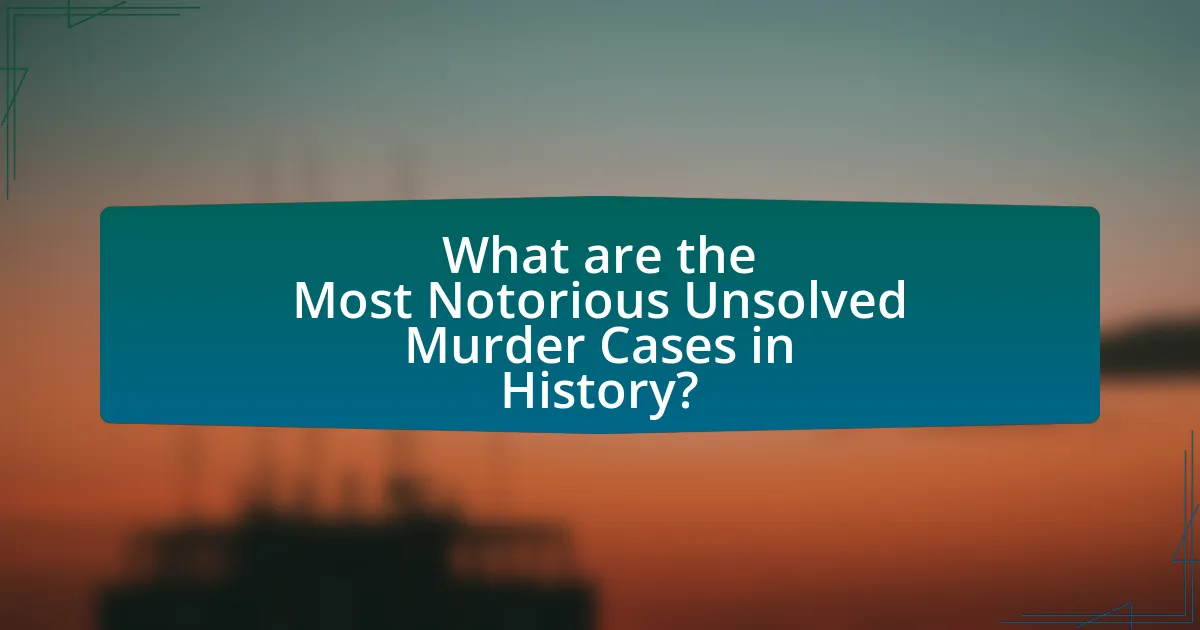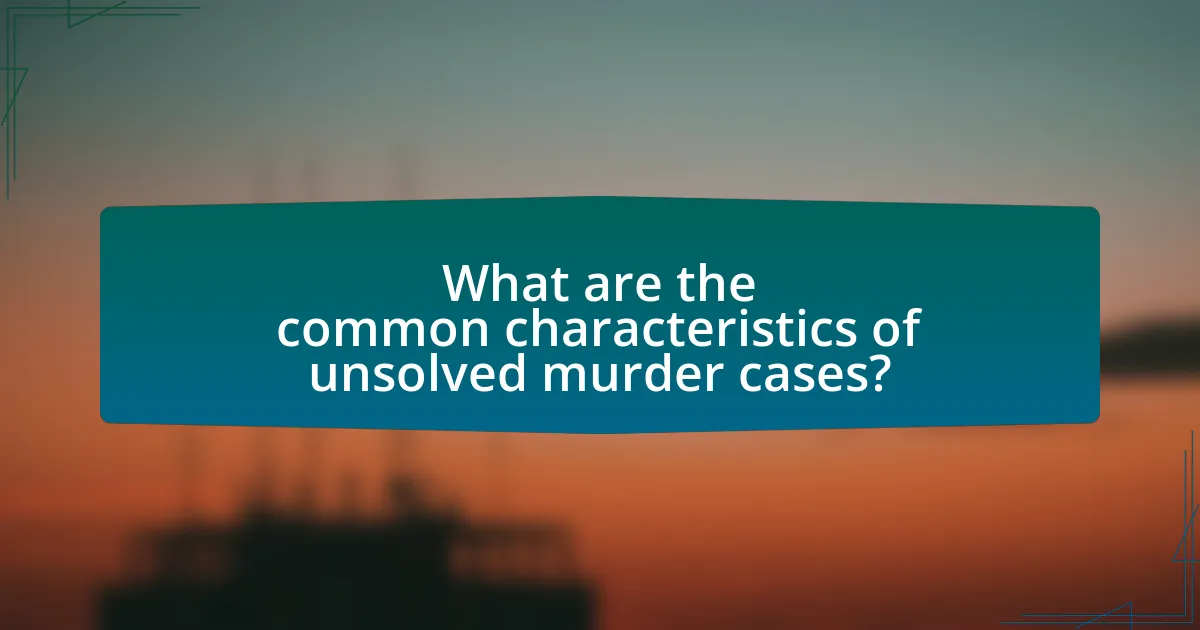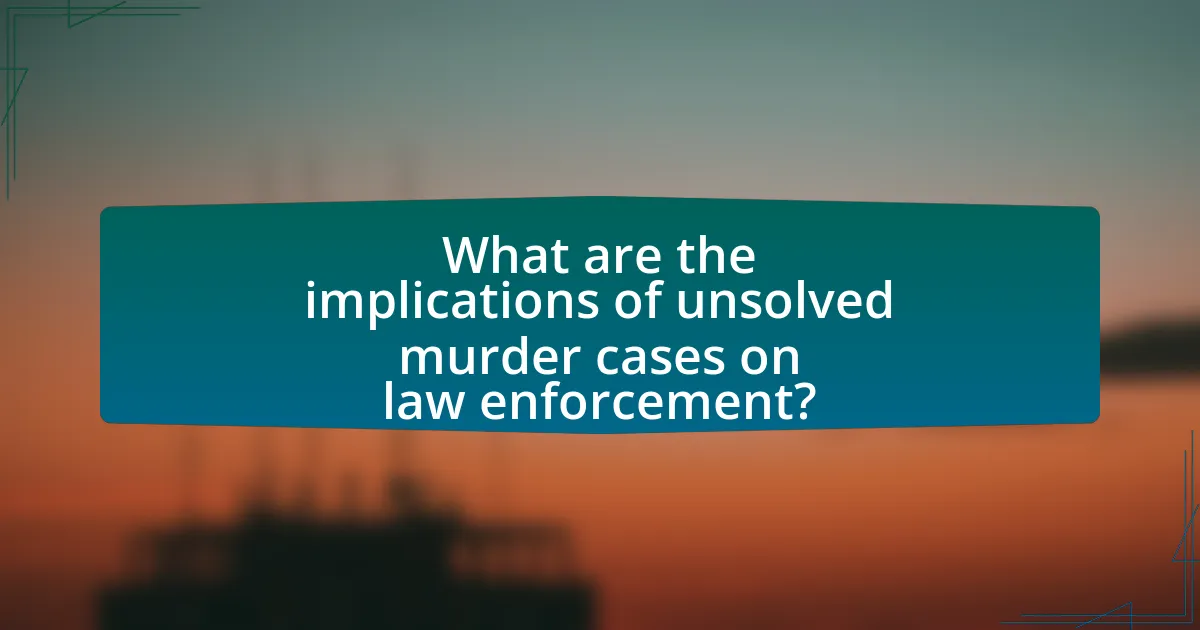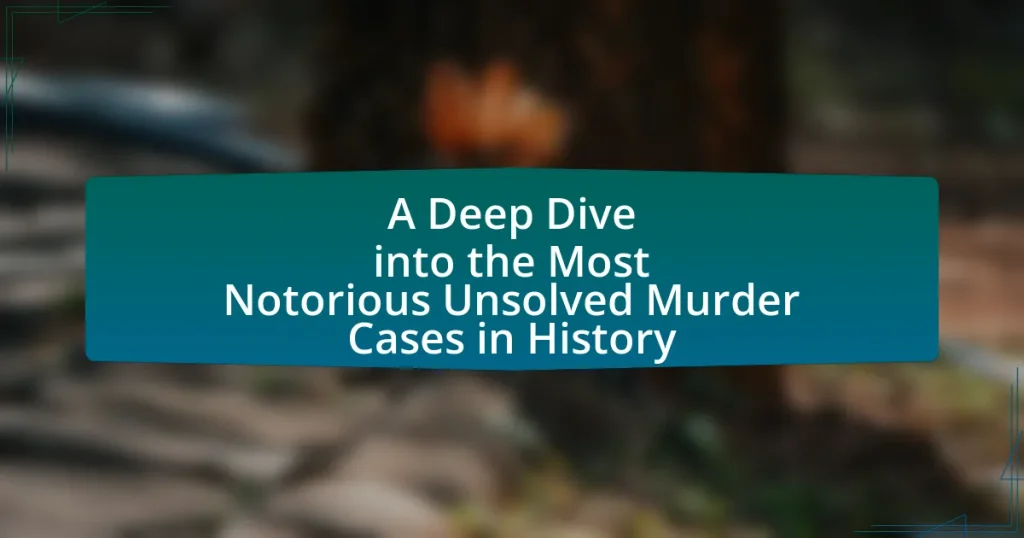The article examines some of the most notorious unsolved murder cases in history, including the Zodiac Killer, the Black Dahlia, and the JonBenét Ramsey case. It explores the reasons why certain murder cases remain unresolved for decades, highlighting factors such as lack of evidence, witness uncooperativeness, and the complexities of crime scenes. Additionally, the article discusses the impact of advancements in forensic technology on cold cases, the role of media and public interest in investigations, and the implications of unsolved murders on law enforcement practices and community trust. It also outlines strategies employed by law enforcement to revisit cold cases and emphasizes the importance of public involvement in solving these enduring mysteries.

What are the Most Notorious Unsolved Murder Cases in History?
The most notorious unsolved murder cases in history include the Zodiac Killer, the Black Dahlia, and the JonBenét Ramsey case. The Zodiac Killer, active in the late 1960s and early 1970s in Northern California, is infamous for taunting police and the media with cryptic letters and ciphers, leading to ongoing investigations without a definitive suspect. The Black Dahlia case involves the 1947 murder of Elizabeth Short in Los Angeles, whose body was discovered mutilated, sparking widespread media attention and numerous theories, yet the killer was never identified. The JonBenét Ramsey case, involving the 1996 murder of a six-year-old girl in Boulder, Colorado, remains unsolved despite extensive media coverage and public interest, with various theories surrounding the circumstances of her death. Each of these cases has left a lasting impact on society and continues to intrigue both amateur and professional investigators.
Why do some murder cases remain unsolved for decades?
Some murder cases remain unsolved for decades due to a lack of evidence, witness cooperation, and advancements in forensic technology. In many instances, critical evidence may be lost or contaminated, making it difficult for law enforcement to establish a clear timeline or identify suspects. Additionally, witnesses may be unwilling to come forward due to fear of retaliation or distrust in the justice system, which further complicates investigations. Historical cases often lack modern forensic techniques, such as DNA analysis, which can provide new leads; for example, the Golden State Killer case remained unsolved for over 40 years until DNA technology was utilized. These factors contribute to the enduring mystery surrounding certain murder cases.
What factors contribute to the difficulty in solving murder cases?
The difficulty in solving murder cases is primarily influenced by factors such as lack of evidence, witness uncooperativeness, and the complexity of the crime scene. Lack of physical evidence, such as DNA or fingerprints, can hinder investigations significantly, as seen in numerous unsolved cases where forensic leads are absent. Witness uncooperativeness often arises from fear of retaliation or distrust in law enforcement, which can limit the information available to investigators. Additionally, the complexity of the crime scene, including multiple potential suspects or motives, can complicate the investigative process, making it challenging to establish a clear narrative. These factors collectively contribute to the high rate of unsolved murder cases, with estimates suggesting that around 40% of homicides in the United States remain unresolved.
How do advancements in technology impact the resolution of cold cases?
Advancements in technology significantly enhance the resolution of cold cases by providing law enforcement with improved tools for evidence analysis and data management. For instance, DNA analysis techniques, such as next-generation sequencing, allow for the extraction and examination of genetic material from old evidence that was previously unusable. According to a study published in the Journal of Forensic Sciences, advancements in forensic DNA technology have led to a 30% increase in the clearance rates of cold cases over the past decade. Additionally, digital forensics, including the analysis of social media and mobile phone data, enables investigators to uncover new leads and connections that were not accessible in earlier investigations. These technological improvements not only facilitate the re-examination of existing evidence but also help in identifying suspects and witnesses, ultimately leading to the resolution of previously unsolved cases.
What are some of the most infamous unsolved murder cases?
Some of the most infamous unsolved murder cases include the Zodiac Killer, the Black Dahlia, and the murder of JonBenét Ramsey. The Zodiac Killer, active in the late 1960s and early 1970s in Northern California, is known for taunting police with letters and ciphers, leading to ongoing investigations without resolution. The Black Dahlia case involves the brutal murder of Elizabeth Short in 1947, whose body was discovered in Los Angeles, and remains one of the most publicized unsolved cases in American history. JonBenét Ramsey, a six-year-old beauty queen, was found murdered in her family’s home in Boulder, Colorado, in 1996, and despite extensive media coverage and investigations, her case remains unresolved. These cases are notable for their enduring mystery and the public fascination they continue to generate.
Who were the victims in these notorious cases?
The victims in notorious unsolved murder cases include Elizabeth Short, known as the Black Dahlia, who was murdered in Los Angeles in 1947; the Zodiac Killer’s victims, such as Darlene Ferrin and Michael Mageau, who were attacked in 1963; and the victims of the Axeman of New Orleans, including Joseph Maggio and his wife, who were killed in 1918. These cases remain infamous due to the lack of resolution and the enduring public fascination with the circumstances surrounding the murders.
What are the key details surrounding each case?
The key details surrounding each case of notorious unsolved murders include the victim’s identity, the circumstances of the crime, and the investigation’s outcomes. For instance, in the case of the Zodiac Killer, the unidentified serial killer operated in Northern California during the late 1960s and early 1970s, taunting police with letters and cryptograms, yet remains unidentified despite extensive investigations. Another example is the Black Dahlia case, where Elizabeth Short was found murdered in Los Angeles in 1947, her body mutilated and posed, leading to numerous suspects but no conclusive evidence. Each case is characterized by a lack of resolution, ongoing public interest, and various theories surrounding the perpetrators, highlighting the complexities and challenges faced by law enforcement in solving these crimes.
How do these unsolved cases affect society and culture?
Unsolved murder cases significantly impact society and culture by fostering a sense of fear and mistrust within communities. These unresolved crimes often lead to public speculation and media sensationalism, which can distort perceptions of safety and justice. For instance, the unsolved case of the Zodiac Killer has not only captivated public interest for decades but has also influenced popular culture, inspiring numerous films, books, and documentaries that reflect societal anxieties about crime and the unknown. Furthermore, the lack of resolution in these cases can lead to a collective trauma, as communities grapple with the unresolved nature of violence and its implications for social cohesion and trust in law enforcement.
What role do media and public interest play in these cases?
Media and public interest significantly influence unsolved murder cases by shaping public perception and driving investigative efforts. The media’s coverage can bring attention to cold cases, often leading to renewed interest from law enforcement and the public, which can result in new leads or tips. For instance, the extensive media coverage of the Zodiac Killer case has kept it in the public consciousness for decades, prompting amateur sleuths and investigators to continue searching for answers. Additionally, public interest can lead to increased funding for investigations or the establishment of reward funds, as seen in the case of the unsolved murder of JonBenét Ramsey, where media attention has spurred ongoing efforts to solve the case.
How do unsolved murders influence crime rates and law enforcement practices?
Unsolved murders significantly influence crime rates and law enforcement practices by creating a perception of increased danger and prompting changes in investigative strategies. The presence of unsolved cases can lead to a rise in reported crime rates, as communities may feel less safe and more vigilant, resulting in higher reporting of suspicious activities. Additionally, law enforcement agencies often adapt their practices by allocating more resources to cold case units and employing advanced forensic technologies to solve these lingering cases. For instance, the FBI’s Violent Criminal Apprehension Program (ViCAP) has been instrumental in analyzing unsolved homicides, leading to breakthroughs in cases that were previously stagnant. This adaptation reflects a broader trend where unsolved murders drive law enforcement to innovate and collaborate with other agencies to enhance their investigative capabilities.

What are the common characteristics of unsolved murder cases?
Unsolved murder cases commonly exhibit characteristics such as lack of physical evidence, absence of eyewitnesses, and insufficient leads for law enforcement. These cases often involve complex circumstances that hinder investigation, such as the passage of time, which can lead to fading memories and lost evidence. Additionally, many unsolved murders occur in areas with high crime rates, complicating the investigative process due to resource limitations. According to the FBI, approximately 40% of homicides in the United States remain unsolved, highlighting the prevalence of these challenges in criminal investigations.
What patterns can be identified among notorious unsolved cases?
Notorious unsolved cases often exhibit patterns such as a lack of physical evidence, the involvement of multiple suspects, and the presence of significant media attention. These cases frequently lack conclusive forensic data, which hampers investigations; for instance, the Zodiac Killer case remains unsolved partly due to the absence of definitive DNA evidence. Additionally, many unsolved cases involve multiple suspects or witnesses, complicating the investigation process, as seen in the disappearance of Madeleine McCann, where various theories and suspects have emerged. Furthermore, high-profile cases tend to attract extensive media coverage, which can influence public perception and investigative approaches, as noted in the case of JonBenét Ramsey. These patterns highlight systemic challenges in solving complex criminal cases.
How do the circumstances of these cases differ from solved cases?
The circumstances of unsolved murder cases differ from solved cases primarily in the availability of evidence and leads. In unsolved cases, critical evidence may be missing, witnesses may be uncooperative or unavailable, and investigative resources may be limited, leading to a lack of conclusive findings. For example, in the case of the Zodiac Killer, despite numerous investigations, the absence of definitive forensic evidence and the killer’s ability to evade capture have left the case unresolved. In contrast, solved cases typically have clear evidence, such as DNA or eyewitness accounts, that directly link a suspect to the crime, facilitating successful prosecution.
What similarities exist in the profiles of victims and suspects?
Victims and suspects in notorious unsolved murder cases often share demographic similarities, such as age, gender, and socioeconomic status. For instance, many victims are young adults, typically between the ages of 18 and 30, and a significant number of suspects also fall within this age range. Additionally, both groups frequently come from similar socioeconomic backgrounds, often reflecting lower to middle-class status, which can influence their interactions and the circumstances surrounding the crime. Studies have shown that in many cases, victims and suspects are more likely to know each other or have overlapping social circles, further highlighting the similarities in their profiles.
Why do some cases gain more attention than others?
Some cases gain more attention than others due to factors such as media coverage, public interest, and the nature of the crime. High-profile cases often involve sensational elements, such as celebrity involvement or gruesome details, which attract media outlets and, consequently, public fascination. For instance, the unsolved murder of Elizabeth Short, known as the Black Dahlia case, garnered extensive media attention in the 1940s due to its brutal nature and the mystery surrounding it, leading to a lasting cultural impact. Additionally, cases that resonate with societal issues, such as racial injustice or systemic failures, tend to receive heightened scrutiny and advocacy, further amplifying their visibility.
What factors contribute to the media coverage of unsolved murders?
The factors that contribute to the media coverage of unsolved murders include the nature of the crime, public interest, and the involvement of law enforcement. High-profile cases, particularly those involving unusual circumstances or notable victims, tend to attract more media attention. For instance, cases that evoke strong emotional responses or have community ties often lead to increased coverage. Additionally, the role of law enforcement in actively seeking media assistance can amplify coverage, as seen in cases where police hold press conferences to solicit tips from the public. Statistics indicate that cases with significant media exposure are more likely to receive public tips, which can aid in solving the crime.
How does public fascination with certain cases impact investigations?
Public fascination with certain cases can significantly impact investigations by influencing the allocation of resources and the direction of inquiry. High-profile cases often attract media attention, which can lead to increased public pressure on law enforcement agencies to solve them quickly. This pressure may result in the prioritization of these cases over others, potentially diverting resources from less publicized investigations. Additionally, public interest can lead to the dissemination of misinformation, which may complicate the investigative process. For example, in the case of the Zodiac Killer, extensive media coverage and public speculation have both aided and hindered the investigation, as amateur sleuths often propose theories that can distract from official leads.

What are the implications of unsolved murder cases on law enforcement?
Unsolved murder cases significantly impact law enforcement by straining resources and undermining public trust. When cases remain unresolved, police departments often allocate substantial time and manpower to investigate leads that may not yield results, diverting attention from other pressing cases. This inefficiency can lead to a backlog of investigations, hampering overall crime-solving effectiveness. Furthermore, the existence of unsolved murders can erode community confidence in law enforcement, as citizens may perceive a lack of accountability and effectiveness in solving serious crimes. Studies indicate that communities with high rates of unsolved homicides often experience increased fear and decreased cooperation with police, further complicating future investigations.
How do cold cases affect police resources and priorities?
Cold cases significantly strain police resources and shift priorities away from current investigations. Law enforcement agencies often allocate limited manpower and funding to revisit unsolved cases, which can detract from addressing ongoing criminal activities. For instance, a study by the Bureau of Justice Statistics indicated that approximately 6% of all homicides in the U.S. remain unsolved, leading to a backlog that can consume valuable investigative resources. This diversion can hinder timely responses to new crimes, as officers may spend extensive hours reviewing old evidence or re-interviewing witnesses instead of focusing on active cases.
What strategies are employed by law enforcement to revisit cold cases?
Law enforcement employs several strategies to revisit cold cases, including the use of advanced forensic technology, re-interviewing witnesses, and reviewing case files for overlooked evidence. Advanced forensic technology, such as DNA analysis and digital forensics, has led to breakthroughs in previously unsolvable cases; for instance, the use of familial DNA has helped solve cases by identifying relatives of suspects. Re-interviewing witnesses can yield new information as memories may change over time, and individuals may feel more comfortable sharing details years later. Additionally, reviewing case files allows investigators to identify inconsistencies or new leads that may have been missed during the initial investigation. These strategies have proven effective, as evidenced by the increasing number of cold cases being solved in recent years, highlighting the importance of persistence and innovation in law enforcement efforts.
How do community tips and public involvement aid in solving these cases?
Community tips and public involvement significantly aid in solving unsolved murder cases by providing law enforcement with crucial information that may not be accessible through traditional investigative methods. For instance, tips from community members can lead to new leads, witnesses, or evidence that can help piece together the circumstances surrounding a crime. A notable example is the case of the Golden State Killer, where public involvement through DNA testing and tips from the community ultimately led to the arrest of Joseph DeAngelo in 2018, decades after the crimes were committed. This demonstrates that active participation from the public can bridge gaps in investigations and enhance the likelihood of solving cold cases.
What lessons can be learned from notorious unsolved murder cases?
Notorious unsolved murder cases teach critical lessons about the limitations of investigative techniques and the importance of public engagement in solving crimes. These cases highlight the need for advancements in forensic science, as many remain unresolved due to insufficient evidence or outdated methods. For instance, the Zodiac Killer case illustrates how a lack of modern DNA analysis hindered progress for decades. Additionally, these cases emphasize the role of community involvement; public tips and awareness can significantly aid investigations, as seen in the case of the Golden State Killer, where renewed interest led to a breakthrough through genealogical DNA testing. Overall, unsolved cases underscore the necessity for continuous improvement in law enforcement practices and the value of collaboration between authorities and the public.
How can these cases inform future investigative practices?
These cases can inform future investigative practices by highlighting the importance of thorough evidence collection and the need for advanced forensic techniques. For instance, the unsolved murder of Elizabeth Short, known as the Black Dahlia case, underscores the necessity of maintaining chain of custody for evidence to prevent contamination. Additionally, the Zodiac Killer case illustrates the potential of utilizing modern DNA analysis and digital forensics, which were not available at the time of the original investigations. By analyzing the investigative missteps and technological limitations faced in these notorious cases, law enforcement agencies can develop more effective protocols and adopt innovative technologies to enhance their investigative capabilities.
What best practices can be adopted to prevent similar cases from remaining unsolved?
To prevent similar cases from remaining unsolved, law enforcement agencies should adopt a multi-faceted approach that includes enhanced training for investigators, improved forensic technology, and community engagement. Enhanced training equips investigators with the latest techniques in evidence collection and interviewing, which can lead to more effective case resolutions. Improved forensic technology, such as DNA analysis and digital forensics, has been shown to significantly increase the likelihood of solving cases, as evidenced by the 2019 report from the National Institute of Justice, which highlighted that advancements in forensic science have led to a 30% increase in case closures. Community engagement fosters trust and encourages witnesses to come forward, as demonstrated by the success of community policing initiatives in various cities, which have led to a notable rise in solved cases.
What resources are available for those interested in unsolved murder cases?
Resources available for those interested in unsolved murder cases include online databases, books, documentaries, and forums. Online databases such as the FBI’s Violent Criminal Apprehension Program (ViCAP) provide detailed information on unsolved cases. Books like “The Encyclopedia of Unsolved Crimes” by Michael Newton offer comprehensive insights into various cases. Documentaries, available on platforms like Netflix and YouTube, explore high-profile unsolved murders, providing visual context and expert commentary. Additionally, online forums and social media groups allow enthusiasts to discuss theories and share information, fostering community engagement around these cases.
Where can individuals find information on cold cases and ongoing investigations?
Individuals can find information on cold cases and ongoing investigations through various sources, including law enforcement agency websites, dedicated cold case databases, and crime-focused media outlets. Law enforcement agencies often maintain online databases that provide details about unsolved cases, such as the FBI’s Violent Criminal Apprehension Program (ViCAP) and local police department websites. Additionally, organizations like the Cold Case Network and the National Missing and Unidentified Persons System (NamUs) compile information on cold cases. Crime-focused media outlets, such as podcasts and investigative journalism platforms, frequently cover ongoing investigations and cold cases, offering insights and updates.
How can the public contribute to solving unsolved murder cases?
The public can contribute to solving unsolved murder cases by providing tips, sharing information, and participating in community awareness initiatives. Law enforcement agencies often rely on tips from the public to uncover new leads; for instance, the FBI’s “Most Wanted” program has successfully solved cases through public assistance. Additionally, community engagement, such as organizing events or campaigns to raise awareness about specific cases, can lead to renewed interest and potential breakthroughs. Statistics show that approximately 20% of solved cases receive crucial information from anonymous tips, highlighting the importance of public involvement in criminal investigations.


